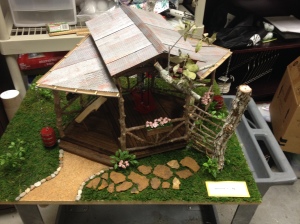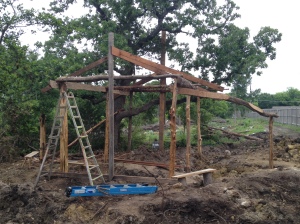A while back I wrote a post on “Geometry and the Homeless.” That post was after my first year if partnering with Mobile Loaves and Fishes Community First on a service-learning project for my advanced geometry students. I have now been blessed to have worked with MLF on service-learning projects for the past three years.
Here is a video on MLF’s heart for the Community First project:
I have worked with geometry students on designing RV covers, gazebos, bike racks, and spiral herb gardens. Below is a picture of last year’s winning gazebo design and the current building progress:
I am beginning my dissertation this summer. It will focus on the benefits of service-learning projects in mathematics and it will specifically examine the partnership between my students and MLF. So needless to say, you can expect a lot of future posts on this topic. Ultimately I believe that service-learning is an incredible way to impact a student’s appreciation of mathematics. To use terminology that I’ve written on before: service-learning is an excellent tool for cultivating mathematical affections.
While you can expect much more on this topic here, I wanted to share a recent video that I came across of other institutions partnering with MLF through the process of service-learning. The institution in the video below just so happens to be my alma mater of Texas A&M (Whoop!): Aggies design, build ‘tiny homes’ for homeless as part of curriculum – The Eagle: Local News.
Tiny House Video from TAMU College of Architecture on Vimeo.
Here are a few quotes from the local article that accompanied the video that speak to the impact of this type of project on the learning outcomes the students experienced:
Construction science senior Laura Malek said working on a project that was going to help a “great cause” was a huge motivator during the process. The project also mimicked a real-life work environment, she said, by bringing together students who wouldn’t normally work together.
“Today was so much fun,” she said. “It was amazing to actually see our work in place and actually get some outside feedback. It felt a little surreal to finally see it there today finished and painted. It meant a lot. People seemed to really enjoy the space and that felt really great after our hard work.”
An interesting side note is that the student quoted in the story is the sister of one of the students that was a part of the first ever service-learning project I initiated (see: Serving through Statistics).
Like I said, there will be a lot more to come on this.
Always feel free to contact me if you have any questions about implementing service-learning into your math class.


